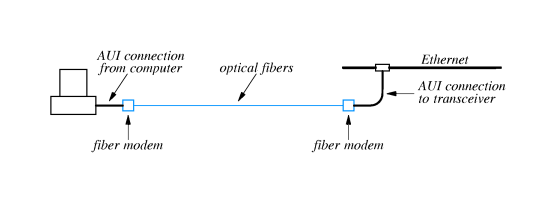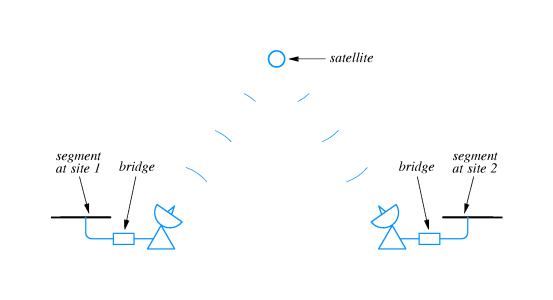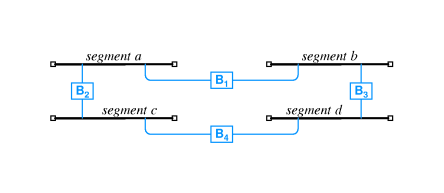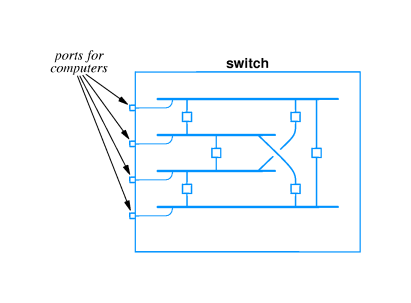(Latest Revision:
Tue Sep 24 10:49:12 PDT 2002
)
Notes On Chapter Eleven
-- Extending LANs: Fiber Modems, Repeaters, Bridges, and Switches
- 11.1 Introduction
- LAN technology is best suited to a network contained, say, with a
single building.
- However sometimes extensions of LANs are
necessary. This chapter is about how to make extensions.
- 11.2 Distance Limitation and LAN Design
- Distance limitation is fundamental to a
LAN.
- If an ethernet is too long two
hosts may send a frame simultaneously before they become aware
that a collision is occuring.
- If a token ring becomes too long it requires too much time for
information to get around the ring.
- there can be so much signal loss as a network grows longer that
frames sent from one end to the other cannot be detected.

- 11.3 Fiber Optic Extensions
- One can connect an office LAN to a remote
computer with a pair of optical modems and some optical fiber.
- The modems take care of translating the signals properly so that
the remote computer operates exactly as though it were connected
to the LAN normally.
- Distances of up to several kilometers are not a problem in this
case because the fiber has low signal loss and high speed.

- 11.4 Repeaters
- One can use ordinary coaxial cable to join
two adjacent ethernet segments if a repeater is inserted at the
join.
- A repeater simply copies each signal received on one side and
transmits it on the other side at full strength.
- A repeater forwards all signals
immediately. It does not buffer frames. It does not "understand"
frames.
- Hosts communicate across a repeater exactly the same way they
communicate on the same segment.
- A 10Base5 ethernet segment can be up to 500 meters in length. No
more than four repeaters may separate any two nodes. Usually it is
easy to stay within these limits when networking a building.
- Although signal strength does not become a problem just because too
many repeaters are in the network, CSMA/CD
will not work reliably when there are too many repeaters between
nodes. This is simply a matter of time delay. If a sending host does not "hear" a collision soon
enough, it will not back off yet the packet may be
unintelligible to the intended receiver.
- The limits for 10Base2 and 10BaseT ethernet are lower, which is
perhaps a reason why a network architect might choose to use 10Base5
technology instead of the newer cheaper 10BaseT.
- One can connect two very distant ethernet
segments using two special repeater/modem devices and an optical
fiber connection between the repeater/modem devices. This
arrangement is much like the one described previously for connecting
a remote computer to a LAN. The tecnology is called Fiber Optic
Intra-Repeater Link (FOIRL).
- Unfortunately, repeaters repeat everything including
collisions and noise. Repeaters fail to
isolate "problem traffic" on a segment.

- 11.5 Bridges
- One can use a bridge to connect two ethernet
segments.
- A bridge is different from a repeater.
- A bridge has two NIC's , one for
connecting to each of the two ethernet segments. (Repeaters don't have NIC's.)
- Hosts communicate across a bridge exactly the same way they
communicate on the same segment.
- When a bridge receives a frame on one side that is addressed to a
node on the other side, it transmits that frame on the other side.
- A bridge waits until it receives a whole
frame, and then commands the NIC on the other side to transmit.
(Repeaters don't wait.)
- A bridge forwards only correct frames, so
therefore it does not forward noise or collisions. (Repeaters forward
everything.)
- Bridges help to keep problems on the net
isolated because they do not forward noise.
- 11.6 Frame Filtering
- Most bridges are adaptive, learning bridges:
they grow a list associated with each of their NIC's.
- The bridge examines the source address of each frame that arrives
at one of its interfaces. It keeps a list
of source addresses on side "A" and source addresses on side "B."
- The bridge also examines the destination address of each frame
that arrives.
- The bridge always forwards broadcast or multicast frames.
- If a frame arrives on side "A" and it is
addressed to a specific host whose address is in the list of sources
on side "A," the bridge does not forward the frame to side
"B" -- because the destination is known to be on side "A" of the
bridge. Otherwise, the bridge does forward the frame.
- 11.7 Startup and Steady State Behavior of Bridged Networks
- Note that "when in doubt" the bridge forwards the frame. Therefore a
bridge will forward all frames until it has learned about some
sources.
- There is an advantage to the "smarts" of a bridge -- isolation of
local traffic. However the CPU of the bridge has to work very hard
-- it needs to processes every frame that arrives on either side.
- 11.8 Planning a Bridged Network
- If segment A is connected to segment B by a bridge, then a pair of
hosts can communicate on segment A at the same time that another pair
of hosts is communicating on segment B.
- When planning a network of segments connected by bridges, one should
try to put hosts that need to communicate
frequently together on the same segment. This will tend to foster a
situation in which many communications between pairs of computers can
go on simultaneously. There will tend to be more throughput
on such a network -- more bits per second of communication among
hosts. Also hosts will tend to spend less time waiting for a
communication to begin.
- Keep in mind, however, that when a frame is not local, it
will not in general get forwarded in a way that "funnels" it to the
destination hosts. In a spanning tree arrangement, the non-local
frame is forwarded onto all segments except it will not be forwarded
to the descendents of the destination's segment.
- 11.9 Bridging Between Buildings
- Because a bridge connects to a LAN exactly like a computer connects,
a bridge can be connected to a far distant segment using a pair of
fiber modems as described in section 11.3.
- 11.10 Bridging Across Longer Distances
- The delay on a segment has to be small so that collision detection
will work properly.
- It's not possible for one host to "collide"
with another host on the other side of a bridge.
- A bridge acts just like any of the other hosts when it puts a
frame on a segment. A bridge participates
in CSMA/CD.
- Therefore if two segments are separated by a bridge, it will not cause incorrect operation of the
network if frames moving from one segement to the other are
delayed for a very long time.

- We can therefore join two very distant
ethernet segments by putting a leased line or satellite
uplink between two bridges, and connecting one segment
to each bridge. There should always be two
bridges in such arrangments, to avoid forwarding packets
unnecessarily across the (low bandwidth) remote link in either
direction.
- Since the leased line or uplink may be very slow compared to the
LAN speed, the bridges used for this kind of connection may be
equipped with a large capacity to buffer (queue) packets.
- 11.11 A Cycle of Bridges
- Any number of ethernet segments can be
connected together using bridges. This provides at least one
solution to the problem of building a large LAN.

- It is possible to join segments with bridges in such a way that
cycles are formed: routes that go through two or more segments and
return to the starting segment.
- Bridge software has to be designed carefully
so that frames will not be forwarded around cycles ad infinitum. For
example, how do we avoid the forwarding of broadcast packets around a
cycle?
- 11.12 Distributed Spanning Tree
- If a network contains a cycle of bridged segments, then we can avoid forwarding cycles by instructing some
bridges not to forward packets.
- When a bridge boots it performs an algorithm that tells it whether it
would create a cycle if it forwards packets. If the answer is yes
then that bridge will not forward packets.
- The bridges that do forwarding form a spanning
tree of the graph whose nodes are segments and whose edges
are bridges.
- 11.13 Switching

- Computers connect to an ethernet switch in the same manner that they
connect to an ethernet hub. However, the hub simulates a single
shared ethernet segment. The switch simulates
a set of bridged segments. The "forwarding" is very
selective. There is a simulated bridge between each pair of
segments. Each host is on one segment alone.
- If 2M computers are connected to a switch, up to M pairs can
communicate through the switch simultaneously.
- 11.14 Combining Switches and Hubs
- Switches are expensive so it is typical to connect a hub to each port
in a switch and then connect computers to the hubs. This arrangement
is similar to a set of bridged LAN segments.
- 11.15 Bridging and Switching with Other Technologies
- Other LAN technologies besides ethernet can make use of fiber modem
connections to distant hosts. It makes sense with token ring or
FDDI.
- FDDI switches exist.
- 11.16 Summary





